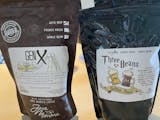Tisanes, AKA herbals
A confusing aspect of learning about tea is that many of the beverages which are called "tea" are actually not tea. Herbal teas, which tea experts term Tisanes (a French word for "herbal infusion"), are usually dried flowers, fruits or herbs steeped in boiling water (no actual tea leaves are included). Historically consumed for medicinal reasons or as a caffeine-free alternative, many tisanes (tih-ZANN or Tea-Zahn) are beginning to find their own popularity outside the tea world. An interesting note: in Europe and some other countries, the use of the word "tea" is legally regulated to only apply to Camellia sinensis. Not so here in the United States...so don't feel bad if you've been confused!
Virtually any flower, fruit or herb that can be steeped in water and ingested can become a tisane. Just take a trip to your local health food store and you'll find dozens of "medicinal herbal teas" boasting a variety of benefits from relaxation to rejuvenation. In this lesson, we'll just focus on a few of the more noteworthy tisanes: some old classics and some new favorites.
Herbal "teas"
The arguably most famous herbal tea finds its roots in ancient Egypt. The first recorded mention of Chamomile being enjoyed was in a document known as the Ebers Papyrus, dating back to 1550 BC. Used to honor the gods, embalm the dead and cure the sick, chamomile has endured lasting fame. This light, sweet, apple-like and floral beverage is still revered for its uncanny calming effect. Who's ready for bed?
Peppermint has been used as a caffeine-free home remedy aiding digestion and soothing the stomach for millennia, dating back to the Greeks. During these times, tables were rubbed with Peppermint to make dining more pleasant. However, not all herbal teas of that time were so pleasant. Some were, in fact, deadly. Philosophers will kindly remind us that Socrates, the father of modern thought, was sentenced to death by drinking a brew known as Hemlock. Hemlock remains unavailable for purchase, due to its unfortunate side effects.
Fruit "teas"
Fruit teas, or tisanes, are caffeine-free blends containing a range of fruits, spices, and herbs. The most common ingredient in fruit teas is Hibiscus, a crimson flower that yields a deep red color to the cup and powerful tart sweetness. Hibiscus is naturally high in Vitamin C. Tea blenders use dried fruits, fruit peel, fruit oils, blossoms, and spices to achieve just the right blend of visual appeal and flavor profile. Fun fact, studies have shown that drinking hibiscus tea can lower blood pressure just as well as the drugs commonly prescribed. Don't take our word for it though, check out the study here.
Rooibos
A newcomer to the tisane scene here in the States, Rooibos (roy - bus) has skyrocketed in popularity. Also known as "Red Bush Tea" or simply "Red Tea," rooibos was introduced as a substitute for black tea. During World War II, virtually all supplies of Japanese and Chinese teas suddenly became unavailable. The tea-addicted Western culture scoured the world for an alternative, finally discovering caffeine-free rooibos, which grows only in South Africa. Rooibos has a rich, slightly sweet flavor that is excellent alone and blends extremely well with a variety of flavors.
Yerba Mate
Finally, the newest drink to the herbal market is called Yerba Mate. This South American botanical from the holly family is consumed throughout much of Brazil, Argentina, Paraguay, Uruguay, and the Far East. Yerba Mate, or simply "Mate", has been lauded as a cultural phenomenon that both energizes and remedies the body. Mate is one of the few plants on earth (along with coffee, cocoa, and tea) that contain caffeine. While the herbal taste tends to be a bit unusual to newcomers (as well as drinking it from the traditional, hollowed-out gourd), after a few sips, most folks embrace it like it one of their own. Originally stranded in the obscurity of the niche cultural market, mate has now been introduced to the US as a substitute for coffee and is attracting wider attention.
Herbal blends - mixtures of these herbs mentioned and many more - are also growing in popularity. The wide diversity of tisanes available makes the combination possibilities virtually unlimited.
No longer a drink merely for the pregnant, caffeine-sensitive or those trying to catch some z's, Herbals have found a new place in the market. Tisanes are beginning to infuse culture with a wide range of tastes and an astounding array of benefits. Do you have a favorite? I'm partial to our rooibos vanilla chai.



